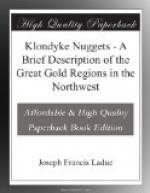“Below Fort Selkirk, the Yukon River is from five to six hundred yards broad, and maintains this width down to White River, a distance of ninety-six miles. Islands are numerous, so much so that there are very few parts of the river where there are not one or more in sight. Many of them are of considerable size, and nearly all are well timbered. Bars are also numerous, but almost all are composed of gravel, so that navigators will not have to complain of shifting sand bars. The current as a general thing, is not so rapid as in the upper part of the river, averaging about four miles per hour. The depth in the main channel was always found to be more than six feet.
“From Pelly River to within twelve miles of White River the general course of the river is a little north of west; it then turns to the north, and the general course as far as the site of Fort Reliance is due north.
“White River enters the main river from the west. At the mouth it is about two hundred yards wide, but a great part of it is filled with ever-shifting sand-bars, the main volume of water being confined to a channel not more than one hundred yards in width. The current is very strong, certainly not less than eight miles per hour. The color of the water bears witness to this, as it is much the muddiest that I have ever seen.[9]
[Footnote 9: The White River very probably flows over volcanic deposits as its sediments would indicate; no doubt this would account for the discoloration of its waters. The volcanic ash appears to cover a great extent of the Upper Yukon basin drained by the Lewes and Pelly Rivers. Very full treatment of the subject is given by Dr. Dawson, in his report entitled “Yukon District and Northern portion of British Columbia.”]
“I had intended to make a survey of part of this river as far as the International Boundary, and attempted to do so; but after trying for over half a day, I found it would be a task of much labor and time, altogether out of proportion to the importance of the end sought, and therefore abandoned it. The valley as far as can be seen from the mouth, runs about due west for a distance of eight miles; it then appears to bear to the south-west; it is about two miles wide where it joins the Pelly valley and apparently keeps the same width as far as it can be seen.
“Mr. Harper, of the firm of Harper & Ladue, went up this river with sleds in the fall of 1872 a distance of fifty or sixty miles. He describes it as possessing the same general features all the way up, with much clay soil along its banks. Its general course, as sketched by him on a map of mine, is for a distance of about thirty miles a little north-west, thence south-west thirty or thirty-five miles, when it deflects to the north-west running along the base of a high mountain ridge. If the courses given are correct it must rise somewhere near the head of Forty Mile River; and if so, its length is not at all in keeping with the volume of its discharge,




